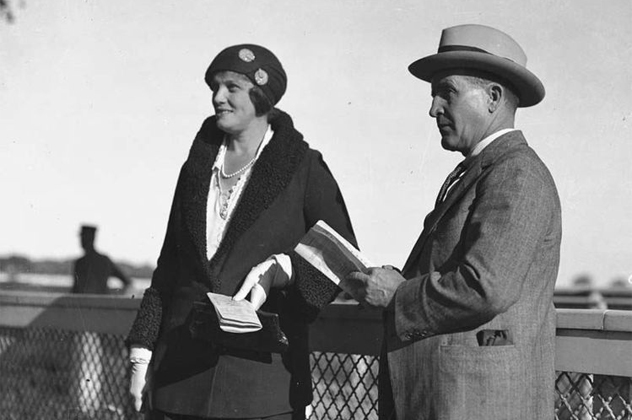 Miscellaneous
Miscellaneous  Miscellaneous
Miscellaneous  Our World
Our World 10 Green Practices That Actually Make a Difference
 Humans
Humans Ten Historic Men Who Deserve Way More Credit Than They Got
 Movies and TV
Movies and TV The 10 Most Heartwarming Moments in Pixar Films
 Travel
Travel Top 10 Religious Architectural Marvels
 Creepy
Creepy 10 Haunted Places in Alabama
 History
History Top 10 Tragic Facts about England’s 9 Days Queen
 Food
Food 10 Weird Foods Inspired by Your Favorite Movies
 Religion
Religion 10 Mind-Blowing Claims and Messages Hidden in the Bible Code
 Facts
Facts 10 Things You Never Knew about the History of Gambling
 Miscellaneous
Miscellaneous Ten Groundbreaking Tattoos with Fascinating Backstories
 Our World
Our World 10 Green Practices That Actually Make a Difference
 Humans
Humans Ten Historic Men Who Deserve Way More Credit Than They Got
Who's Behind Listverse?

Jamie Frater
Head Editor
Jamie founded Listverse due to an insatiable desire to share fascinating, obscure, and bizarre facts. He has been a guest speaker on numerous national radio and television stations and is a five time published author.
More About Us Movies and TV
Movies and TV The 10 Most Heartwarming Moments in Pixar Films
 Travel
Travel Top 10 Religious Architectural Marvels
 Creepy
Creepy 10 Haunted Places in Alabama
 History
History Top 10 Tragic Facts about England’s 9 Days Queen
 Food
Food 10 Weird Foods Inspired by Your Favorite Movies
 Religion
Religion 10 Mind-Blowing Claims and Messages Hidden in the Bible Code
 Facts
Facts 10 Things You Never Knew about the History of Gambling
10 Completely Mysterious Deaths We’ll Probably Never Solve
We’ve covered plenty of unsolved deaths at Listverse before. Unfortunately, the world is as keen to offer misery as it is to withhold answers. There’s been no shortage of speculation around these 10 stories. However, the passage of time only serves to take us further away from events, and the world of speculation will likely be the final resting place of these mysterious deaths.
10Tom Thomson

Canadian painter Tom Thomson was last seen setting out on a fishing trip in a canoe on July 8, 1917. When his body was found floating in Canoe Lake eight days later, the circumstances behind the young artist’s demise became one of Canada’s most infamous mysteries.
There were two unusual aspects of the body that led many to believe he hadn’t simply fallen overboard: A piece of fishing line was wrapped 16 times around Thomson’s left ankle, and there was a wound on his temple. Some investigators agree with the accidental drowning theory, but if it was an accident, what caused it? It’s possible that Thomson’s canoe simply hit a piece of floating debris from a nearby logging operation. Some have even suggested the unlikely—but technically possible—scenario that he was hit by a sudden tornado.
Others have suggested that Thomson received a blow to the head, possibly from a paddle. There’s also the possibility of suicide—that Thomson purposely drowned himself, using the fishing line to tie a weight around his ankle.
The murder theories are even more numerous. Among the proposed suspects are American draft dodgers hoping to stay anonymous and poachers going to desperate lengths to hide their activities. Perhaps enemy spies or saboteurs were hiding in the woods, planning to attack the nearby train tracks used to transport goods bound for the war effort in Europe. None of them would have wanted Thomson to report spotting them.
9The Missing Body Of Frederick McDonald

On April 15, 1926, former Australian MP Frederick McDonald disappeared and was never seen again. His body was never found, but a suicide note was. No one was ever questioned about or charged with the disappearance, but one person frequently receives the finger of suspicion—Thomas John Ley.
Ley became a member of Australia’s federal parliament in 1925, and his ambition was matched only by his reputation as an awful person. Shortly after he gained his federal seat, he was investigated for bribery, having apparently offered McDonald £2,000 to back out of the next election. Then, before the hearing, McDonald apparently decided to kill himself.
Another of Ley’s enemies, Hyman Goldstein, “committed suicide” by throwing himself off a cliff in 1928. Goldstein was another MP who had been tricked into investing in a scam company set up by Ley. Goldstein set up a committee to investigate his fellow politician, but before the investigation could take place, Goldstein’s body was being dragged out of the sea by a fishing trawler.
Ley’s willingness to murder was proven in 1946, by which point he had moved to England. He’d become convinced that his mistress was having an affair with a young barman named John Mudie, so he had Mudie strangled and dumped in a chalk pit. Ley was convicted and died of a stroke after one year in a hospital for the criminally insane. It’s likely that he took the secret of McDonald’s fate with him.
8The Blazing Car Murder

In 1930, Alfred Rouse attempted to fake his own death by bludgeoning a man over the head with a mallet and burning the body in his car. He was spotted fleeing the scene and was eventually hanged for the crime. However, the identity of his victim was unknown.
For a long time, it was thought that the victim may have been William Thomas Briggs. Briggs had gone missing on his way to a doctor’s appointment around the time the murder took place. He was similar in appearance to Rouse and would have made an ideal victim for the hoax.
At the start of 2014, members of Briggs’s family arranged to have DNA tests done to finally put the mystery to rest. But when the results came back, the DNA didn’t match, opening up two separate mysteries. Who was the man murdered by Rouse, and what actually happened to Briggs? While the latter question will probably never be answered, DNA technology may eventually lead to the identification of the murder victim.
7Julia Wallace

The 1931 murder of Julia Wallace in Liverpool has fascinated British crime writers for decades. It’s been called an unparalleled mystery that compares only to the infamous murders perpetrated by Jack the Ripper.
On January 20, 1931, a man calling himself R.M. Qualtrough called Liverpool Central Chess Club with a message for one of its members, William Herbert Wallace. The club’s secretary took the call and passed on the request for Wallace to go to 25 Menlove Gardens East the following evening. Wallace worked as an insurance agent, so such things weren’t particularly unusual.
When Wallace got to the area the following evening and tried to find the road, he found that there was a North, a South, and a West Menlove Gardens—but no East. Assuming someone had played a prank, he made his way back home, where he found his wife brutally murdered in the living room.
William Wallace was convicted of the murder, but the verdict was overturned after an appeal. Two other suspects have been considered. One was 22-year-old Richard Parry, who’d lost his job working for Prudential Insurance when William Wallace caught him fudging the books. Another was Joseph Marsden. Julia Wallace had been paying Marsden for sex, a fact he wanted to keep secret as he was about to marry into a wealthy family.
Several books have been written about the murder, and each new writer has been convinced that they’ve finally solved it—yet none of them actually agree on the outcome.
6Laetitia Toureaux

When Laetitia Nourrissat Toureaux boarded a metro that left Porte de Charenton station in Paris at 6:27 one evening in May 1937, she was the only person in the first-class carriage. When it pulled into the next station just a minute later, three people boarded through the doors on both ends of the carriage. Toureaux was still the only person there, but now she was slumped forward with a dagger protruding from her neck.
It’s partly the impossibility of the murder that makes Toureaux’s death so fascinating, but she also lived an unusual life. By day, the Italian widow worked in a glue factory. At night, she frequented seedy nightclubs and worked as a surveillance and message-delivery specialist for a private detective agency. This eventually led to her becoming a paid informant for the Parisian police, a position that definitely came with enemies.
She is also believed to have been having an affair with Gabriel Jeantet, a prominent right-wing journalist. Jeantet was also an arms smuggler for the most powerful underground organization in Paris at the time, a terrorist group called the Comite secret d’action revolutionnaire. Their nickname was the Cagoule, literally “hooded,” as they wore hoods to protect their identities.
The group was funded by the city’s social and financial elite, and it waged a campaign of terror in an attempt to break trade unions and other left-leaning organizations. They were responsible for seven confirmed murders, two bombings, and the formation of a militia. They even stockpiled weapons and built an underground prison.
In 1937, two members of the group were placed under interrogation. They claimed that Toureaux’s murder had been committed by their chief assassin, Jean Filliol. One of the men later changed his story, and the other man had been beaten prior to giving the information, so it’s hard to be certain how much they actually knew.
In any case, World War II soon put a halt to the investigation, and by the mid-1940s, Filliol had fled to Spain. Other rumors suggest that Toureaux was killed because she knew too much about a plot involving Mussolini, as the dagger-in-the-neck technique was popular with professional assassins from Italy. By the time police were in a position to resume their investigation, there were too many obstacles in their way, leaving Toureaux’s murder a mystery to this day.
5Harry Oakes

The richest man in the Bahamas was found dead on the morning of July 8, 1943. He’d been beaten in the head with a spiked club, doused in gasoline, and covered with feathers from a pillow. The murderer had then tried to set him on fire, but the blaze hadn’t taken.
Harry Oakes had made his money in the gold mines of Canada before moving to the Bahamian capital of Nassau to escape taxes. The governor of the islands at the time was the Duke of Windsor, formerly the King of England. He’d been friends with the recently deceased Oakes and, rather than allowing the local police to investigate, he called in two detectives from Miami whom he knew personally.
It wasn’t long before Oakes’s son-in-law, Alfred de Marigny, was arrested and charged. Oakes had never liked de Marigny, and the young man stood to inherit a large fortune if Oakes died. That gave de Marigny two motives, so when his fingerprint was found at the crime scene, he was immediately put on trial. The defense showed that the duke’s private detectives had planted the fingerprint in order to bring an end to the situation as soon as possible, and de Marigny was acquitted.
Another key suspect was Oakes’s business partner, Harold Christie, who had been staying at the house that night. Christie claimed that he’d been asleep and had heard nothing around the time Oakes was killed. He had a motive, as he owed Oakes money that he couldn’t pay. De Marigny himself wrote after his trial, “In my mind there is no doubt whatsoever that Harold Christie should have been tried and hanged for the murder of Sir Harry Oakes.”
Witnesses later claimed to have seen Christie out of the house around the time the murderer would have expected the body to be going up in flames, even though he denied ever leaving. Christie was never really investigated, and never received a trial. Others have blamed the Mafia, who had hoped to organize a gambling racket in the Bahamas (possibly in cahoots with the Duke of Windsor) but had run into opposition from Oakes.
4The Atlas Vampire

Lilly Lindestrom was a 32-year-old divorcee living in Stockholm in the 1930s. She lived in a small apartment and made her living as a prostitute. On May 1, 1932, she was discussing plans for the evening’s May Day celebrations with her friend Minnie Jansson, a 35-year-old woman who lived on the same floor and made her living in the same way. Lilly was nicknamed the “call girl” because she was the only person in the building with a phone.
Lilly received a call from a potential client, asking if he could come over. Lilly agreed, and Minnie left her to it. Minnie only saw her friend alive again briefly later that day, when the younger woman called to borrow condoms. When Minnie knocked on Lilly’s door several hours later, there was no answer. Minnie thought that perhaps Lilly had gone to the celebration with the man.
It wasn’t until three days later that the police were finally called. When they broke down the door, Lilly was found facedown on her bed, completely naked, with a condom still in her anus. She’d been killed by three blows to the head from a blunt object. Her clothes were neatly folded nearby.
Yet there was an even more disturbing and sinister aspect to this murder. In the room was a bloodstained gravy ladle. Further inspection revealed that the blood had been drained from Lilly’s body, and the killer had used the ladle to drink it. Despite the authorities’ best efforts, the story leaked, and the local press nicknamed the unknown killer the Atlas Vampire, due to the area of the city in which Lilly lived.
Eighty of Lilly’s customers were investigated, but no suspects were revealed. Minnie hadn’t recognized the voice on the phone from what she’d heard, but she commented that the man had seemed sober and polite. There didn’t seem to be any fingerprints on any of the suspicious items at the scene. One theory was that the killer was a police officer who had bludgeoned Lilly with his truncheon and knew how to cover his tracks. Either way, Lilly’s final customer was never found.
3Mary Money

Late in the evening on September 24, 1905, the mutilated body of a young woman was found in the Merstham railway tunnel in southeast England. At first, police believed that it may have been suicide, but an examination of the body found a scarf which had been stuffed down the woman’s throat. The body was warm, and had likely not been there long—maybe less than 30 minutes—by the time a railway worker stumbled across it.
Shortly after a description was released, the victim was identified as Mary Money by her brother Robert. Police set about retracing her last steps. Around 7:00 PM, she’d told a friend that she was going for a walk and would be back soon. Her body was found around 10:55 PM.
Two witnesses claimed to have seen her at the local train station that evening. Others noted that they’d seen a young woman in a first-class compartment with a man. The train in question would’ve passed through Merstham tunnel at around 10:19. One witness said he saw the man leave the train alone. Was he a boyfriend who had thrown Mary out of the moving carriage? The police investigated every man in Mary’s life, but all had solid alibis.
Later events suggested that Mary’s brother may have been less than honest with the police. He was found dead in 1912, having murdered two women and three children before committing suicide. The women were sisters, and Robert had married them both without the other’s knowledge. Having proven himself very capable of deceit and murder, a role for Robert in his sister’s murder doesn’t seem unreasonable.
2YOGTZE

Gunther Stoll was found severely injured in his car in the early hours of the morning in 1984. The car was in a ditch on the side of the autobahn. He’d been out drinking the previous night, and the case seemed like nothing more than a simple traffic accident. Unfortunately, he died on the way to hospital before he could give an explanation for the accident. The subsequent examination of Stoll’s injuries led authorities to conclude that he’d been run over before being placed back in his vehicle.
Another puzzle came from a note found beside Stoll. On a scrap of paper, he had written “YOGTZE.” It’s not a word in any language that anyone has been able to find. It may be an acronym or possibly an encryption, but if that’s the case, nobody’s cracked the code. The day before he died, Stoll had declared to his wife, “Now I get it!” before he made the note and left the house.
Two decades later, the death and the note both remain a mystery. People have speculated that it may have been YO6TZE, a Romanian radio call sign. It could also be a reference to the yogurt flavoring TZE (Stoll worked as a food technician). Neither of those ideas, however, give any insight into how Stoll ended up apparently murdered in his own car, and the case remains unsolved.
1Charles Bravo

The death of Charles Bravo is another case that many modern sleuths claim to have solved, each one with a different story. Bravo was a barrister who died of antimony poisoning in 1876. His painful death was strung out over several days, yet Bravo remained calm and unwilling to tell anyone who may have put the poison into his bedside water glass. Many at the time took this ambivalence to be a sign that Bravo had poisoned himself as a means of suicide, though we now know that his behavior could have simply been a symptom of the poisoning.
There were four main suspects. The first was Florence, Charles’s wife of four months, who had started to loathe her husband’s intense sexual advances. Then there was Dr. James Gully, Florence’s former lover (and the suspect thought most likely by Agatha Christie). On the other hand, the maid, Mrs. Cox, had heard she was to be fired and may have held a grudge against Bravo. Finally, there’s a theory that the murderer was actually Charles Bravo, and he accidentally poisoned himself while trying to kill his wife.
Of course, there’s also the possibility that it wasn’t murder at all—just an accident. Like many heavy metals, antimony was used to treat various illnesses in the 19th century. The case that ruined the lives of its suspects—Gully’s career was in tatters and Florence drank herself to death within 18 months—may have been nothing more than a botched home remedy.
Alan is blaming every single one of these on Jessica Fletcher.








